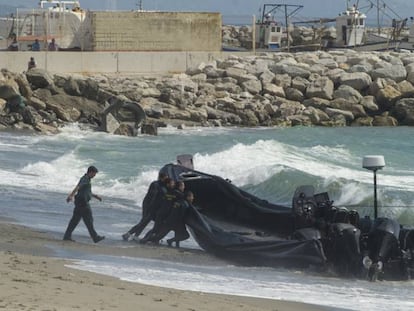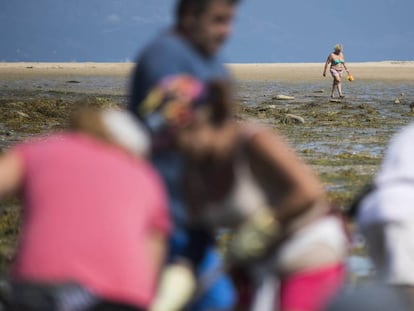When your grandpa smuggled tobacco and coffee
Smuggling between Portugal and Spain was rampant under dictator Francisco Franco

Vicente no longer fits into his wedding suit. Although he was always short, as a young man he was stocky. Now, at 78 years of age, he has a pronounced belly like a mountain without a peak. It is a personal statement: eating, after the war and dictatorship, was a revolutionary act for families, an act that compensated for years of hunger.
Vicente married Severina when he was 22 years old – just months after losing his brother, and his mother wanted Vicente to wear a black corduroy suit at the ceremony as a sign of mourning. Severina said to her future mother-in-law: ”I will not marry your son like this.” Vicente traveled to Portugal three nights in a row to get “some duros” (one duro is slang for five pesetas) by smuggling. With this money he bought a “good quality suit.” “Made from good material,” adds Severina.
They sacrificed themselves so they could feed their families Town Hall official Maite Barroso
In the border between Portugal and Spain, known as la Raya (the Line), poor families supplemented their income by smuggling, a practice that had been around in the area since the 15th century.
From age 15, Vicente balanced his day job in an olive field with smuggling at night. He would travel four times a week to Foios, the first town across the border into Portugal from Eljas. Crossing the mountains, it was 8km on foot. “My boss gave me 15 duros. To buy the suit, I took over double the load and he gave me 20 per night,” recounts Vicente.
A blanket wrapped around you and a bag over your shoulder – that was the typical outfit for smugglers. That’s how they describe it in the Spanish towns Eljas, Oliva de la Frontera (Badajoz) and El Granado (Huelva). Here they did not make offerings to the Virgin Mary but to smugglers. “In 1995, Eljas and Foios became sister towns. What brought us together? Smuggling,” explains Antonio Bellanco, the mayor of Eljas, who also trafficked goods at the end of the 70s. “We would walk to Foios to pick up coffee. To get tobacco we would go to Aranhas, which was further so we had to go on horseback.”
In El Granado, smugglers crossed the Guadiana river to get to Santana de Cambas where they would pick up coffee. Maite Barroso, from the Santana de Cambas town hall, points out that the town’s monument, erected in 2011, is a “tribute not to illicit activity but rather to the tough conditions that many families had to live through.” “They sacrificed themselves so they could feed their families,” he adds.
In 1995, Eljas and Foios became sister towns. What brought us together? Smuggling Mayor of Eljas Antonio Bellanco
Rafael Caballero, from Oliva de la Frontera, is one of the promoters of the hiking club Los Mochileros (The Backpackers), named in homage to the backpacks carried by smugglers. Not only does the town have a monument, there are also organized hiking tours that follow the smugglers’ routes. “We show people where they hid, how they oriented themselves, and the field they crossed when it got dark,” says Caballero. He explains that after the war, flour and cigarette lighters began to be smuggled. Followed by coffee. Returning from the Portugal towns of Barrancos and La Marilleja: “They would carry 40 kilos on their back, five in their hands. If they had to run from the Civil Guard, they would ditch the 40 kilos and keep the five. This was what was called their ‘lifesaver’.”
Between Galicia and Andalusia there are 1,200 km. The towns which fall in the middle are geographically and politically isolated. The border is as a kind of apartment block where the Portuguese are literally neighbors who you could go to to ask for a bit of salt or sugar. Smuggling, which was once so widespread that under the dictator Francisco Franco even priests and mayors took part in it, is today a cultural product.
English version by Melissa Kitson.
Tu suscripción se está usando en otro dispositivo
¿Quieres añadir otro usuario a tu suscripción?
Si continúas leyendo en este dispositivo, no se podrá leer en el otro.
FlechaTu suscripción se está usando en otro dispositivo y solo puedes acceder a EL PAÍS desde un dispositivo a la vez.
Si quieres compartir tu cuenta, cambia tu suscripción a la modalidad Premium, así podrás añadir otro usuario. Cada uno accederá con su propia cuenta de email, lo que os permitirá personalizar vuestra experiencia en EL PAÍS.
¿Tienes una suscripción de empresa? Accede aquí para contratar más cuentas.
En el caso de no saber quién está usando tu cuenta, te recomendamos cambiar tu contraseña aquí.
Si decides continuar compartiendo tu cuenta, este mensaje se mostrará en tu dispositivo y en el de la otra persona que está usando tu cuenta de forma indefinida, afectando a tu experiencia de lectura. Puedes consultar aquí los términos y condiciones de la suscripción digital.
More information
Archived In
Últimas noticias
Most viewed
- Reinhard Genzel, Nobel laureate in physics: ‘One-minute videos will never give you the truth’
- Oona Chaplin: ‘I told James Cameron that I was living in a treehouse and starting a permaculture project with a friend’
- Pablo Escobar’s hippos: A serious environmental problem, 40 years on
- Charles Dubouloz, mountaineering star, retires at 36 with a farewell tour inspired by Walter Bonatti
- Why we lost the habit of sleeping in two segments and how that changed our sense of time










































